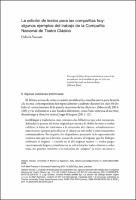Chapter La edición de textos para las compañías hoy: algunos ejemplos del trabajo de la Compañía Nacional de Teatro Clásico
| dc.contributor.author | VACCARI, Debora | |
| dc.date.accessioned | 2022-06-01T12:25:42Z | |
| dc.date.available | 2022-06-01T12:25:42Z | |
| dc.date.issued | 2021 | |
| dc.identifier | ONIX_20220601_9788855182249_675 | |
| dc.identifier.issn | 2704-5919 | |
| dc.identifier.uri | https://library.oapen.org/handle/20.500.12657/56490 | |
| dc.description.abstract | The debate about to what extent the comedia nueva can and should be modified for the contemporary scene has always been very lively. In order to understand the different positions about this issue, I study the work of the Compañía Nacional de Teatro Clásico by analyzing four versions of two different comedies, El perro del hortelano and El burlador de Sevilla, with the aim of finding out how the different adapters have worked and the way they have proceeded over time. | |
| dc.language | Spanish | |
| dc.relation.ispartofseries | Studi e saggi | |
| dc.subject.other | Siglo de Oro | |
| dc.subject.other | Compañía Nacional de Teatro Clásico | |
| dc.subject.other | version | |
| dc.subject.other | El perro del hortelano | |
| dc.subject.other | El burlador de Sevilla | |
| dc.title | Chapter La edición de textos para las compañías hoy: algunos ejemplos del trabajo de la Compañía Nacional de Teatro Clásico | |
| dc.type | chapter | |
| oapen.identifier.doi | 10.36253/978-88-5518-224-9.06 | |
| oapen.relation.isPublishedBy | bf65d21a-78e5-4ba2-983a-dbfa90962870 | |
| oapen.relation.isbn | 9788855182249 | |
| oapen.series.number | 218 | |
| oapen.pages | 33 | |
| oapen.place.publication | Florence |

